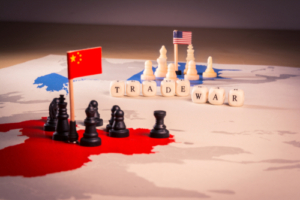Understanding the New Trade Dynamics: A Closer Look at U.S.-China Coal Tariffs

As the U.S.-China trade relationship continues to evolve, one recent development has raised eyebrows and sparked fierce debate: China’s decision to implement a 15% tariff on U.S. coal. This retaliatory measure comes in response to the ongoing tensions between the two nations and could have significant ramifications for the coal industry, particularly for states heavily reliant on coal exports.
A Snapshot of Coal Exports to China
In 2024, the United States shipped 11.6 million tons of coal to China, accounting for approximately 6.46% of all U.S. coal exports. This substantial figure has brought attention to specific states that dominate the coal trade. Notably, West Virginia exported around 6 million tons of coal, representing a staggering 14% of the nation’s coal production. But it’s not just West Virginia; states like Wyoming, Pennsylvania, Illinois, and Kentucky play critical roles in the U.S. coal landscape, with Wyoming leading the charge at a notable 41.2% of national production.
The targeted nature of the tariff raises questions: Is China aiming to strike a blow against U.S. political dynamics by adversely impacting predominantly red states? While the historical context suggests this could be a possibility—Canada has previously sought to penalize Trump’s backers—political maneuvering may be less of a focus than pure economic strategy.
The Global Coal Market: Who Really Wins?
Interestingly, while China’s coal imports from the U.S. are significant, it doesn’t heavily rely on American coal to meet its needs. The country predominantly sources coal from larger suppliers such as Australia, Indonesia, Russia, and Mongolia. In fact, Australia leads the world in coal production, contributing an impressive 33.7% of the total supply. In stark contrast, U.S. coal accounts for roughly 7% of global production, illustrating the shifting dynamics in the coal market.
Despite these tariffs, India emerges as the largest importer of U.S. coal, marking a turning point in the geopolitical chess game surrounding coal trade. In 2024 alone, India imported 28.2 million tons of coal, reflecting an 8% uptick from the previous year. Furthermore, China has increased its coal purchases from India by an astonishing 54%, showcasing the complexities of international trade dynamics amid rising tensions.
The Economic Fallout of Tariffs
Beyond immediate effects, these tariffs and sanctions could be seen as counterproductive, undermining a once-robust trade relationship between the U.S. and China. Both countries historically benefited from this collaboration; the U.S. relied on China not only as a key trading partner but also as a purchaser of American debt. However, as the geopolitical climate shifts, the possibility of cooperation grows increasingly slim.
At Extreme Investor Network, we believe that understanding these new economic dynamics is essential for investors, policymakers, and individuals alike. The multi-faceted relationships at play show just how interconnected global economies are. As the U.S. and China navigate the complexities of economic competition, markets must adapt to these new realities, particularly within sectors like coal that are burdened by geopolitical pressures.
Conclusion
The implementation of tariffs on U.S. coal by China not only signals changing trade relations but also highlights the intricate web of global supply chains and political maneuvering. As we navigate through uncertain economic landscapes, staying informed on these shifts is key. Join the conversation at Extreme Investor Network, where we offer insights beyond the headlines — let’s delve deeper into understanding how these developments will shape our economic future. Stay tuned for more expert analysis on the evolving relationship between major global players and how it impacts your investments!

